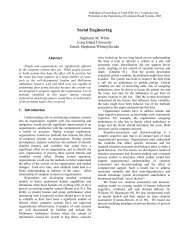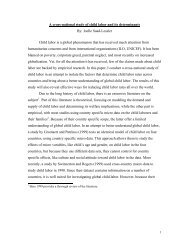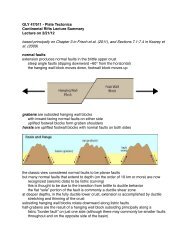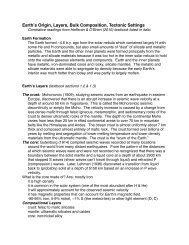lecture 1 - Myweb @ CW Post
lecture 1 - Myweb @ CW Post
lecture 1 - Myweb @ CW Post
Create successful ePaper yourself
Turn your PDF publications into a flip-book with our unique Google optimized e-Paper software.
(<strong>lecture</strong> on 9/8/08)<br />
Introduction: Hazards and Risk, Energy Sources for Natural Disasters<br />
==================================================================<br />
Natural Disasters and Humans, Hazards and Risk (Chapter 1 and supplemental)<br />
Energy Sources for Natural Disasters (Chapter 2 and supplemental)<br />
==============================================================<br />
Natural Disasters and Humans, Hazards and Risk<br />
objective: to study the natural Earth processes tat pose hazards to humans and<br />
methods of reducing risks from these natural hazards.<br />
key points: we must study<br />
1) physical processes in the dynamic Earth system<br />
especially those associated with unusual or extreme events<br />
2) effects on people, property and infrastructure<br />
3) methods of monitoring so as to try to predict extreme events<br />
4) methods to mitigate the effects of extreme effects<br />
Extreme events are not disasters. Natural processes and the occasional extreme<br />
events are not disasters. They are just ongoing natural processes. But they do pose<br />
natural hazards for humans, depending on how well suited our property/infrastructure/<br />
habits are to these natural processes.<br />
Extreme events simply refer to the largest of the naturally occurring events. Large<br />
magnitude events occur relatively rarely compared to the average event for Earth<br />
processes.<br />
Natural disasters occur where humans and natural processes, particularly extreme<br />
events, collide with human activity.<br />
The 40 deadliest disasters, 1970-2005 include hurricanes, earthquakes, tsunamis,<br />
heatwaves, floods, volcanic mudflows, and snowstorms.<br />
Between 1947 and 1980, the largest number of people died in hurricanes followed<br />
closely by earthquakes.<br />
The monetary cost of natural disasters has grown more than tenfold through the last<br />
half-century as global population has approximately doubled, and development has<br />
also greatly increased. Population is still growing fastest in developing nations,<br />
those who are least able to prepare for and cope with the aftermath of natural<br />
disasters. The global cost of natural disasters in 2004 was over 73 billion dollars<br />
(equivalent to about 3.5% of the U.S. federal budget for that year). Natural disasters<br />
cost ~73 billion dollars per year in the U.S.
Developed countries overall experience much higher monetary losses and low human<br />
losses. Developing countries have high casualties and more modest monetary<br />
losses due to less development.<br />
Definitions<br />
Hazard (H) refers to the possibility of a dangerous event. Hazard can be expressed as<br />
a statistical probability of a given magnitude event occurring in a specific area within<br />
a specified length of time.<br />
Vulnerability (V): the level of loss expected from an extreme event (of a given<br />
magnitude). It can be quantified from 0 (no loss) to 1 (total loss).<br />
Specific Risk (Rs): the probability of a loss. Quantitatively, is is the product of Hazard<br />
and Vulnerability (Rs = H x V).<br />
Net Impact: the difference between disaster losses and the benefits of using the<br />
hazardous area.<br />
Medical Consequences<br />
Mortality: number of deaths<br />
Morbidity: number of injured<br />
Traumas: numbers of burns, contusions, fractures, lesions, etc.<br />
morbidity > mortality in earthquakes and hurricanes<br />
mortality > morbidity in landslides, floods, volcanic eruptions<br />
Types of Disasters<br />
geophysical origin: earthquakes, tsunamis, volcanic eruptions, landslides, etc.<br />
climatic origin: hurricanes tornadoes, severe thunderstorms, floods, drought, fire, etc.<br />
biological origin: epidemics, parasite invasions, etc.<br />
human origin: warfare, terrorism, urban fires, building collapse, etc.<br />
Recurrence Intervals<br />
Low or moderate magnitude events generally occur frequently while large magnitude, or<br />
extreme events generally occur rarely.<br />
The Disaster Cycle<br />
Impact - Response - Recovery - Mitigation - Preparation - Next Impact
Energy Sources of Natural Disasters<br />
(see the extensive notes in the <strong>lecture</strong> slides online)<br />
The sources of energy for natural disasters are:<br />
- internal heat that drives geophysical processes like the motions of plates,<br />
earthquakes, and volcanoes<br />
- solar radiation which drives the water cycle, weather and storms<br />
- gravity which causes landslides and tidal processes<br />
- impacts by extraterrestrial bodies<br />
Origin of the Earth - Origin of Earth’s Primordial Heat<br />
solar nebula hypothesis<br />
heat in early Earth derived from<br />
- gravitational compression<br />
- impacts<br />
- radioactive decay (greater than today)<br />
differentiation of Earth’s core, mantle, crust, hydrosphere, and atmosphere<br />
Earth’s Internal Heat Engine<br />
- interior is hot today because of primordial heat and continuing radioactive decay<br />
- mantle convection<br />
Energy from Outside the Earth<br />
- solar energy accounts for 99.98% of the energy at the Earth’s surface<br />
- the water cycle is driven by solar radiation<br />
- the rock cycle is driven partly by internal heat, partly by solar radiation (and gravity)<br />
Constructive and Destructive Forces<br />
- internal energy drives mountain building, volcanoes, etc. which build up the land<br />
- solar energy drives the water cycle responsible for weathering and erosion of land<br />
Energy Sources of Extreme Events<br />
- energy accumulates gradually over time<br />
- when energy is suddenly released, extreme events occur<br />
- the human built environment is designed mainly for the gradual flux of energy but may<br />
be damaged or destroyed by sudden energy release (extreme events)<br />
Internal Heat Energy<br />
- earthquakes<br />
- tsunami<br />
- volcanoes<br />
Solar Radiation<br />
- severe weather<br />
- tornadoes<br />
- tropical cyclones (hurricanes, typhoons, cyclones)<br />
- floods<br />
- drought, fires
Gravitational Energy<br />
- landslides & avalanches<br />
- erosion<br />
- tides<br />
Impact Energy<br />
Tiny impacts occur constantly. Large impacts occur rarely, but when they do:<br />
- impact craters<br />
- shock wave<br />
- earthquake and tsunami<br />
- molten ejecta<br />
- thermal transient<br />
- fires<br />
- sudden, short term cooling<br />
- extinctions
















